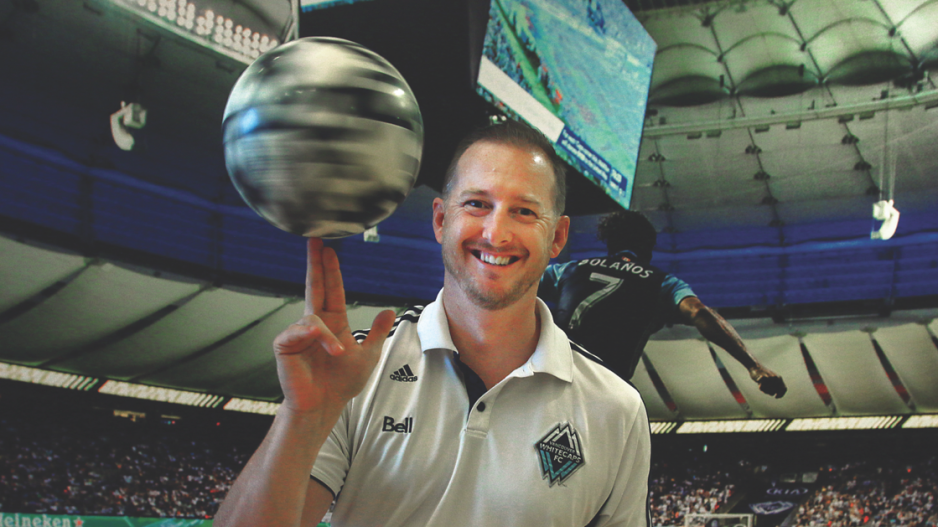As the BC Lions and Vancouver Canucks struggle to fill seats for home games, the Vancouver Whitecaps FC are riding a wave of enthusiasm among millennial fans and an overall rise in Major League Soccer (MLS) viewership across North America.
A survey by U.S. research firm Simmons found that about 44% of MLS fans are between the ages of 21 and 39, and a recent Public Policy Polling report found that 59% of all MLS fans are under the age of 45, the lowest average age of any North American professional sports league.
According to a Whitecaps survey, more than 40% of the team’s regular ticket holders are under the age of 40, and of those over 40, roughly half are bringing children and young adults to the games with them.
Colby Fackler, Whitecaps vice-president of sales and service, noted that after a 2017 season in which the team finished third in the league’s Western Conference and made a conference finals appearance, it will be opening the full lower bowl for the season opener on March 4 versus the Montreal Impact.
Fackler added that a rise in the number of millennials – loosely defined as those born between the early 1980s and early 2000s – attending games is something that’s hitting every MLS franchise, and that it makes up a “big component of our demographic.”
“All the numbers that the league is getting and that we’re getting for our fan base is that it’s considerably younger, especially in comparison to sports like baseball and football,” Fackler said.
He added that the average Whitecaps fan is in his or her early to mid-30s, and several factors might be helping to draw young people, including cheap tickets, a two-hour game and flexible ticket packages.
BC Place’s lower bowl has a capacity of 27,837, but the Whitecaps usually trim that down to 22,120 for regular-season games.
During the conference semifinals, the Whitecaps sold out the entire lower bowl for a game against the Seattle Sounders and twice expanded capacity to 25,083 during the regular season for games against the Los Angeles Galaxy and the Portland Timbers.
Total regular home attendance for the Whitecaps has risen consistently since 2011, when the team had 346,909 total fans for 17 home games. In the 2017 season, the Whitecaps drew 364,073, and 14 times the organization has had crowds of more than 22,500 for matches.
Fackler said the team has looked at opening up the upper bowl for playoff games, which would give BC Place a full capacity of 54,500, and it will revisit the idea this season if the Whitecaps host a home playoff game.
“Should we have made it through to the conference finals last year we would have taken a hard look at it,” he said. “I think the reality is that you’d have to put a minimum of another 10,000 people up there; otherwise the experience for the people up there, they might as well be going to an empty stadium.”
In 1999, the MLS had 12 teams; the league is expected to grow to 28 by 2020. The biggest MLS team by revenue is the Los Angeles Galaxy (US$63 million annually). The Whitecaps generate an estimated US$20 million, according to a Statista study.
Luis Aguiar, an associate professor of sociology at the University of British Columbia’s Okanagan campus, said there are two factors at play when it comes to Whitecaps fans: economics and culture. Aguiar, who plays soccer and has taught a fourth-year sociology class on the fame of Real Madrid star Cristiano Ronaldo, noted Whitecaps fans give a “cosmopolitan” impression, but they aren’t necessarily well-heeled citizens. He noted there is a real distinction between a BC Lions fan and a Whitecaps fan.
“Millennials work in different industries than your average football fan. I think football is a sport of the postwar period, this industrial working-class kind of identity and masculinity that I’m not sure necessarily resonates with millennials.”
Lower ticket prices compared with the cost of getting into Canucks games have helped raise the Whitecaps’ profile with millennials, Aguiar said. He added that the relatively short length of soccer games is also an advantage. Soccer matches run two hours, while hockey games can take upward of three hours if a shootout is needed; and football games can run up to four hours.
“I think the other thing for millennials is they’ve grown up in a different environment,” he said. “Most of the students I teach have travelled more than I have. And now the globalization [of soccer] has come to North America, and I think there was an audience that was starved for that. And soccer has come along at the right time for this generation.”
Peter Girges, owner of West Oak restaurant, Pierre’s Lounge and Twelve West nightclub, said millennial Whitecaps fans frequent his establishments during the season. He noted their drink of choice is craft beer, and they are easy to spot when they come in even if they’re not wearing jerseys.
“One hundred per cent, and it’s always good for business when there’s a game,” he said while chatting at West Oak in Yaletown. “They definitely have that millennial look and swag about them, which is great. I find a lot of Whitecap fans even live downtown; they’re locals. They’ll come eat here during the week or maybe have a business meeting, and they come eat here pre-game and have beers with their buddies.”




